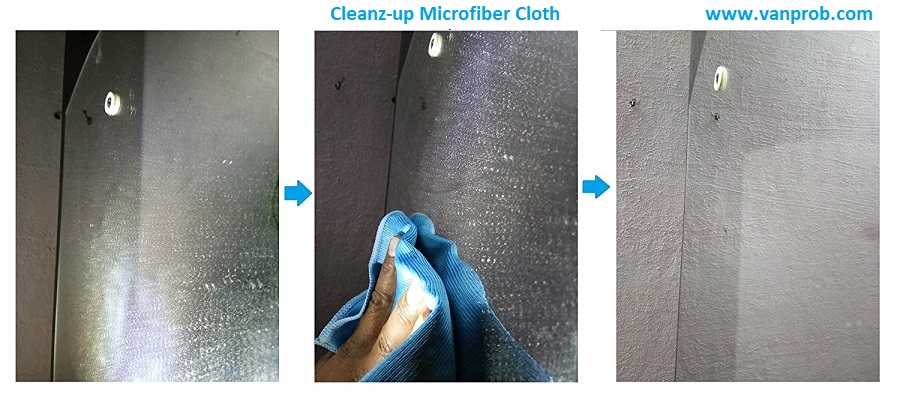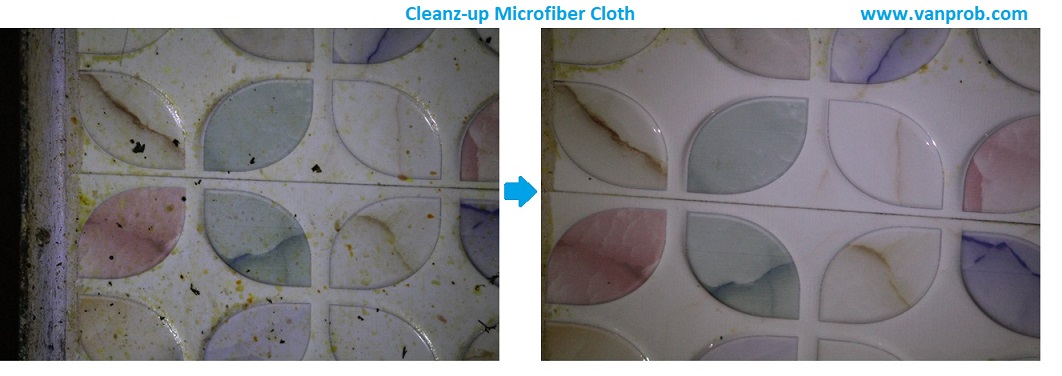Microfiber Cleaning Cloth - Lint Free, Streak Free, Double Sided, Multipurpose

Use Wet for Cleaning & Forget Chemicals, Reusable Lint Free, Super Absorbent, Quick Drying, Use on Any Surface
Microfiber Cloth will Clean with only Tap Water and Without any chemicals (in most cases)
✓ Use Wet Cloth for Cleaing and Dry Cloth for Drying
✓ MicroFibers hold Dust, Dirt and Black Soot (Grime)
✓ One Side Soft for Easy Surface & Other Side Coarse Rough for Tough Scrub Job
✓ Streak Free Finish, Captures Dust, Dirt, Grime more effectively
✓ Durable & Machine Washable, Reusable
✓ Lint Free, Dries Faster, Super Absorbent
✓ Save Money on buying - Tissue Paper, Cleaning Chemicals
✓ Save Time - Cleaning Time is reduced drastically by 50% to 90%
✓ Save Efforts - Regular Wiping job becomes easy
✓ Size of each towel - 40 cm x 40 cm(Custom Size Available)
✓ Use on Anything - Any Surface Glass, Mirror, Furniture, Stainless Steel, Chrome, Granite, Marble, Tap, Wood, Car, Bike, Electronics (Mobile, Computer) etc
Cleaning Pics - No Photoshoot


What is microfiber?
Microfiber is defined as a fiber that is 1 denier or less. What is a denier? It’s a measurement of fineness equal to a unit of fiber that weighs one gram for each 9000 meters…meaning it is really small. To put it in perspective, microfiber is 1/100 the diameter of a human hair and 1/20 the diameter of a strand of silk. One square inch of microfiber has approximately 200,000 fibers.
Why Microfiber Cloths Are So Great
When compared to cotton cloths, Microfiber cloths perform better at most household cleaning tasks because they:
• Leave no lint or streaks behind
• Can hold up to 8 times their weight in water
• Won’t scratch delicate surface
• Can clean nearly any surface with just water
• Split fibers grab dirt and other particles
• Very easy to clean and maintain
• Environmentally friendly and economical
Can you use it to dust?
You can use these cleaning wonders in many areas of your home and office. Split Microfiber is positively charged which attracts the negatively charged dust particles like a magnet. This makes it more effective (and safer) than a regular cloth and chemical spray for dusting. Even better, you can just rinse it when you done to release all the dust and then you can use it wet.
Will it work when it's wet?
When your towel is wet, it works great on smudged dirt, grease and stains. The towel works best when you rinse it and the wring it out as it needs some absorbency to pick up grime.
Will it leave streaks on windows?
Because Microfiber is so absorbent, it is perfect on windows and surfaces that tend to streak. Since these towels can hold up to 7x their own weight in liquid, there is nothing left to streak the surface. This also makes it better than paper towels when cleaning up spills.
Where and how can I use Microfiber towels?
- Anywhere you would normally use a paper towel or cloth towel
- Dusting your home or office
- Scrubbing / Polishing bathrooms
- Cleaning appliances
- Wiping down kitchen counters
- Car interiors and exteriors
- Wiping down the shower (drying off after each shower/bath)
- Cleaning mirrors, glass
- Dishcloths
Using Microfiber has allowed me to get rid of:
- Furniture polish
- Daily shower sprays
- Glass cleaners
No need to buy any of these products anymore, which helps your supplies budget, and you don’t have to spray them in home, which improves our indoor air quality and ultimately, the health and well-being of my family.
How to Use Microfiber Cloths
Microfiber cloths are best used dry for dusting and damp for cleaning. You can use our Microfiber cloths for pretty much every cleaning task you can think of:
Dusting and polishing surfaces
Use a dry cloth to quickly and easily remove dust from surfaces. The Microfiber is positively charged, while dust is negatively charged; so the cloth acts almost like a dust magnet, trapping the dust particles in one place instead of flying around everywhere.
Polish your chrome faucets and fixtures with a couple of quick swipes of the cloth, and they’ll be clean and shiny in no time.
Cleaning glass and mirrors
Simply use a slightly damp cloth to clean the surface, wiping up dirt, debris and fingerprints, etc. Then, use a dry cloth to buff the area to a streak-free shine. You don’t even need any type of window cleaner here.
Wet/dry mopping floors
Microfiber mops are all the rage right now because they’re lightweight and ergonomic, making them much easier to use than the standard wet mop/bucket. Use your floor cleaner and just spray it on your floors and wipe them clean with the mop.
Cleaning kitchen counters and stovetop
Wipe down the kitchen counters and stovetop with a damp cloth to clean up everyday kitchen messes. And if you feel so inclined, you can always add a few sprays of cleaner for extra cleaning power.
Cleaning bathroom sinks, tubs, showers, and counters
Hang a Microfiber cloth inside the cabinet door in my bathroom and use it to do a daily wipe down of the counters, sink, and faucet. Then just rinse out, wring it out, and hang it back up. The bathroom always looks fairly clean and it makes the deep clean days that much easier.
After (almost) every shower or bath, I try to also dry all the wet surfaces with a Microfiber cloth. Any soap scum build up is quickly and easily scrubbed away by the tiny fibers. Of course there are times where one just neglects this so in that case, Water Stain develop, you can use Hard Water Stain Remover.
Cleaning up messes and spills
A quick swipe with a Microfiber cloth soaks up liquids, cleans up dirt and grime, and wipes away any mess leaft behind. Just rinse it out and hang it near the sink, so it’s ready for the next job.
Wiping down stainless steel appliances and chrome faucets
Use a damp cloth to wipe down your stainless steel appliances and chrome faucets, Grimy handprints on the fridge or something, and spray some all-purpose cleaner before wiping it down, but it usually doesn’t even need that.
Cleaning baseboards
Use damp Microfiber cloths. These cloths pick up everything that collects on those baseboards and leaves them good as new.
How to Care for Microfiber Cloths
One of the wonderful benefits of Microfiber cloths is how easy they are to clean and maintain. Just a few tips to keep in mind, to ensure longer life and maximum effectiveness:
- Rinse cloths out after each use, then hang to dry
- Wash them with regular detergent, but DO NOT use bleach or fabric softeners
- It's best if you hang dry them, but if you have to use the dryer make sure you use a low heat or air dry cycle
- Try to avoid washing them with other laundry that’s prone to lint as they'll just collect the lint
What's the best way to use Microfiber cloths
You'll need to experiment! The first time you use one, force of habit will probably make you soak it with water and add loads of soap as well—both of which will reduce the cloth's effectiveness.
The best way to use these cloths is with as little water as possible. If you're cleaning very dirty windows, for example, use a Microfiber Cloth and soapy water to wash all the dirt off first. Then rinse them thoroughly with clean water and use a Dry Microfiber Cloth to get them almost dry, and let them dry in the air for just a little longer.
At this point, with hardly any water remaining on the glass, polish over with your Microfiber cloth—and you'll be amazed at the smear-free, sparkling finish. If your windows aren't too dirty to start with, simply use the Microfiber cloth by itself with a little water